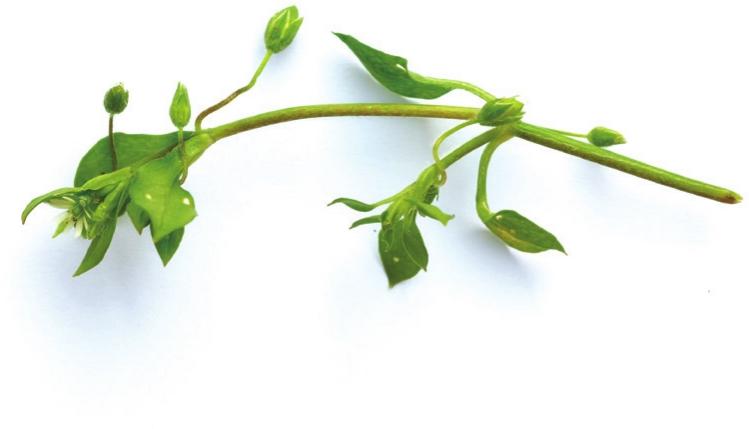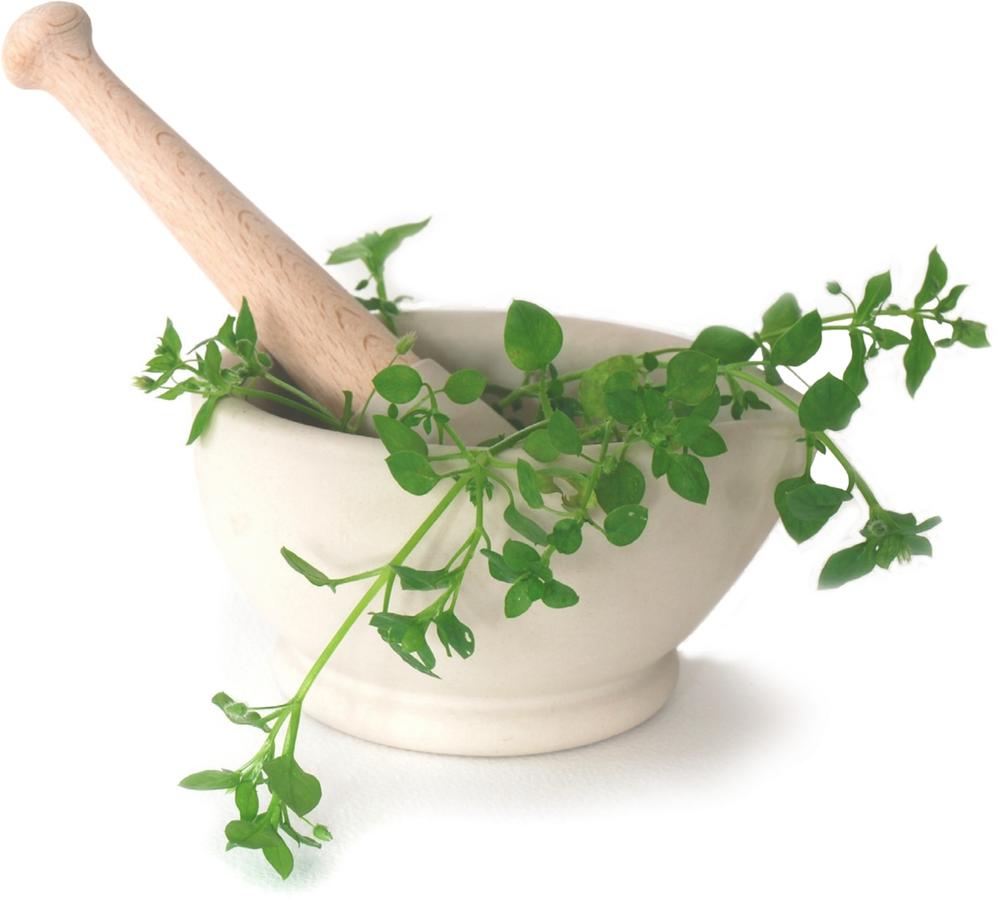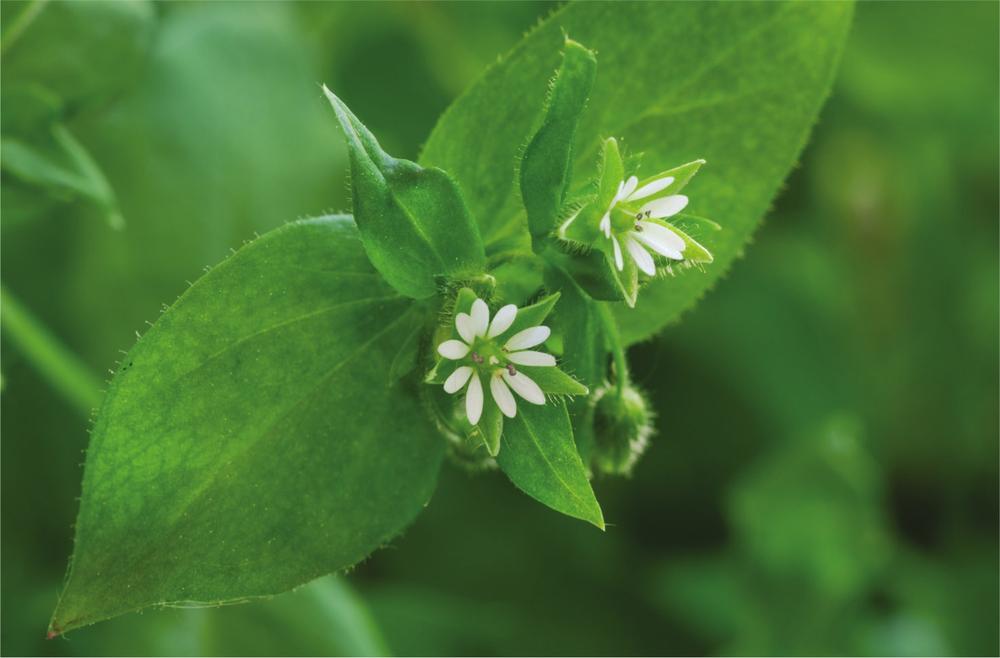This is the best-known herbal remedy for itchy skin and hot skin inflammations of various types. Chickweed is a soothing, nutritious and cooling herb, with a reputation for clearing stubborn, long-lasting bodily conditions.
It has special affinities for the eyes, lungs and chest, and can be eaten as a food. As you’ll see, it is far more than chickenfeed!

Caryophyllaceae Pink family
Description: A floppy, sprawling annual plant with soft green leaves and tiny star-like white flowers.
Habitat: Gardens, hedgebanks and waste-ground.
Distribution: Very common throughout the British Isles. Native to Europe and Asia but now found as a weed worldwide.
Related species: There are three other less common species of chickweed found in the British Isles: greater chickweed (S. neglecta), lesser chickweed (S. pallida) and water chickweed (Myosoton aquaticum). Mouse-ears look similar, but are hairy and more upright.
Parts used: Above-ground parts, gathered whenever vibrant and green.
Chickweed has some less familar old names, like chick wittles, clucken wort and chickeny weed, which confirm it is as a fowl favourite. This can be attested worldwide: for example, Julie’s grandmother in Australia had chickens that loved their chickweed. Matthew’s mother in Cambridgeshire can vouch for the relish with which her caged canaries used to nibble fresh chickweed flowers and seeds. Not surprisingly, it is also called bird seed.
But why should birds have all the fun? Chickweed is an excellent salad plant for humans, especially in late winter and early spring, when there’s little else green and fresh available for foraging.
It tastes as though it is full of chlorophyll, has an earthy, slightly salty tang and is easily gathered. Its high vitamin A and C levels, saponins and plentiful minerals, including iron, copper, magnesium and calcium, make it one of the best spring tonics.
Chickweed has long been eaten fresh this way by country people and it was once sold in the streets of London. Chickweed is tender and juicy, and has been called the tenderest of wild greens.
We often harvest it fresh for salad. Chickweed on its own is perhaps an acquired taste, but it is bland and goes well in a mixed salad. The tastiest way we have found to eat it is to make it into a pesto with pine nuts, which is surprisingly good (see recipe).
Chickweed is available almost all year round, except in midsummer when it becomes fibrous and in midwinter when it disappears. It is one of the most genteel of weeds, easily pulled up and never rambunctious. Its presence signals fertile soil and it helps keep the soil moist. And once you find how good it is, you’ll never seem to have enough of it!
One help in identifying chickweed among its Stellaria cousins is its very commonness, in the British Isles and around the world. Chickweed is a very floppy plant and has smooth light green leaves, with one line of hairs up the side of the stem. In any event, other members of its clan have similar herbal attributes, such as lots of vitamins A and C and steroidal saponins, and can be used safely, if less effectively.

Use chickweed for…
Chickweed makes a good broth or tea for children and convalescents and can be taken in quantity. One American herbalist writes with gusto of taking ‘quarts of chickweed a day’.
Herbally, the best-known external use for chickweed is to soothe itches, bites, stings, inflammations, burns, swellings, sunburn, bruises, splinters and sore eyes. It makes a good and readily found first-aid or emergency remedy – pull up a handful and place directly onto the affected part. If you have a little more time, crush some chickweed with a mortar and pestle and bandage the paste against the wound or bite as a poultice. This is very cooling and soothing for sunburn.
Chickweed has the particular reputation of resolving skin problems where some form of heat is involved and where other herbs or creams have failed, especially when a cooling, drawing action is needed.
It is also known for clearing up long-standing or ‘indolent’ damage, such as eczema, rheumatic joints and varicose veins.

It is also safe for delicate organs that need cooling and soothing. One special affinity it has is for eye inflammations of most sorts, including itchiness from a contact lens. Dioscorides, the Greek scientist, described a chickweed recipe nearly two thousand years ago: he added crushed chickweed to corn meal to produce a paste that was poulticed onto the affected eye.
We mentioned before that chickweed contains saponins. Saponin means ‘soap-like’. If you take a handful of the plant and rub it in your hands with a little water, you may not actually get a lather, but you’ll feel the soapiness and it’ll leave your hands feeling lovely and soft, if smelling a little of chickweed.
Saponins work at a cellular level to increase absorption and permeability. What this means is that inflamed organ membranes, as in the liver, kidneys and lungs, are helped by saponins to absorb healing nutrients, as well as allowing their wastes and blockages to be more easily removed. Add to this the cooling qualities of chickweed, and you have a wonderful, subtle herbal cleanser and restorer at work, far beyond the familiar and dismissive uses for ‘itchiness’.
Chickweed works well internally on hot inflammatory problems like gastritis, colitis, congested chest, blocked kidneys and gallbladder, and piles. It has an affinity for the lungs, for sore throats, bronchitis, asthma, irritable dry cough and other respiratory conditions.
Another quality you may come across is chickweed’s reputed value as a slimming aid. Chickweed water or tea is an old wives’ remedy for the overweight, and dried chickweed is indeed added to some proprietary slimming preparations.
What do herbalists say? Some believe it does work, as the saponins help to dissolve body fat; others note it stimulates urination, so will assist in shedding body moisture, which would contribute to weight loss. As with many treatments, what works for one person may not be effective for everyone.
Chickweed has a valuable toning action for the body’s internal organs. In American herbalist Susun Weed’s words, it ‘sponges up the spills’ and ‘tidies up the rips’. She refers to its ‘deep mending skills’, and to its ability to relieve, clear, protect and nourish.
Chickweed can also be made into a flower essence, which is used to help release the past and focus in the present moment. If you want to make a chickweed essence, follow the instructions given for selfheal essence on page 154.
Whether as a salad, tea or tincture, essence or vinegar, chickweed is effective, available, free and safe.
Chickweed pesto
Pick a few handfuls of chickweed, removing any brown bits and roots. Break off the larger stems, as they have a very strong stretchy fibre at their core and are surprisingly stringy for such a floppy plant. Put the rest in a blender with a handful of pine nuts, a couple of cloves of garlic and enough olive oil to make it blendable. Blend until it is as smooth as you like it, then serve fresh on pasta with some grated pecorino or parmesan cheese. It can also be eaten with rice or other grains, or used as a sauce for vegetables.
Chickweed bath
For itchy skin, especially if this is over a large area of your body, try adding chickweed to a bath. Put a few handfuls of fresh chickweed in a sock or tie in a square of muslin, and use a piece of string to hang this under the hot tap so that the water flows through it as you run your bath. Oatmeal can also be mixed with the chickweed for additional soothing. Once the bath is run, gently squeeze the sock or bag to release more of the contents.
Alternatively, make a strong infusion of chickweed, strain and add to the bath water.
Chickweed bath vinegar
Pick chickweed and put it in a blender, adding enough cider vinegar to blend. Strain and bottle. Your vinegar will start out a light lime green and change after a day or two to a lovely golden colour. Add a couple of tablespoons to bath water. This recipe combines chickweed’s effectiveness at relieving itchy skin with vinegar’s acidity, which helps restore the natural protective acid balance of the skin. It is particularly good if you live in a hard-water area.
Chickweed vinegar can also be used in salad dressings.